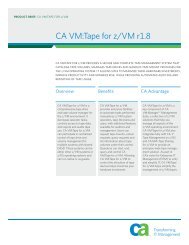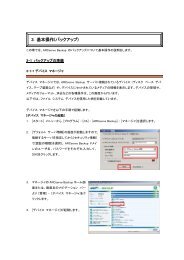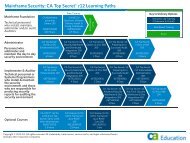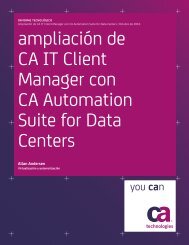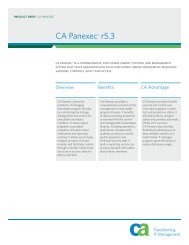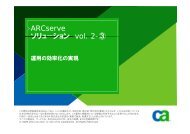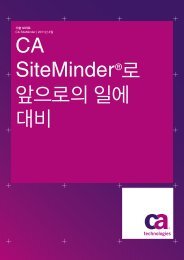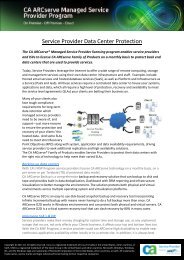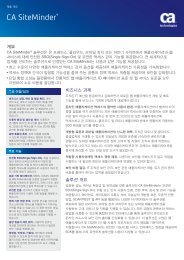Content-Aware Identity and Access Management - CA Technologies
Content-Aware Identity and Access Management - CA Technologies
Content-Aware Identity and Access Management - CA Technologies
Create successful ePaper yourself
Turn your PDF publications into a flip-book with our unique Google optimized e-Paper software.
<strong>CA</strong> <strong>Technologies</strong> Point of View: <strong>Content</strong>-<strong>Aware</strong> <strong>Identity</strong> <strong>and</strong> <strong>Access</strong> <strong>Management</strong>In addition, these products can improve security for new or emerging service models, such as virtualized orcloud environments. As you take advantage of virtual computing, you will want to ensure that the physicalmachines that host your virtual environments are fully protected from attack or cross-VM access. In asimilar way, as you move to cloud computing, you need to make this transition as easy <strong>and</strong> secure aspossible. <strong>Content</strong>-<strong>Aware</strong> IAM from <strong>CA</strong> <strong>Technologies</strong> facilitates your ability to make this transition securelyso that you business can take advantage of these new <strong>and</strong> important service <strong>and</strong> technology models.<strong>Content</strong>-<strong>Aware</strong> IAM from <strong>CA</strong> <strong>Technologies</strong> provides important capabilities to leverage information contentknowledge to improve overall security, including:• <strong>Content</strong>-<strong>Aware</strong> information classification Data needs to be classified according to the model of datasensitivity of each organization. For example, there should be major categories of information sensitivity(examples: corporate confidential, customer private, intellectual property, nonpublic info, etc.), aswell as levels of sensitivity within each category. This process today is usually manual, highly timeconsuming<strong>and</strong> error-prone, <strong>and</strong> often completely omitted. <strong>CA</strong> DataMinder can analyze <strong>and</strong> classifysensitive information (using either static or dynamic analysis) <strong>and</strong> then control its usage to preventmisuse. Traditional IAM vendors do not provide this important capability, <strong>and</strong> this is the foundationon which <strong>Content</strong>-<strong>Aware</strong> IAM is based.• <strong>Content</strong>-<strong>Aware</strong> provisioning The integration of <strong>CA</strong> <strong>Identity</strong>Minder <strong>and</strong> <strong>CA</strong> DataMinder provides trueidentity-centric information protection. <strong>CA</strong> <strong>Identity</strong>Minder can directly provision, de-provision, <strong>and</strong>modify users into the <strong>CA</strong> DataMinder user hierarchy. As users’ roles change, <strong>CA</strong> <strong>Identity</strong>Minder passesthose changes into <strong>CA</strong> DataMinder, which ultimately changes each user’s data usage entitlements.• <strong>Content</strong>-<strong>Aware</strong> web access management <strong>CA</strong> SiteMinder can use information classification in its policyenforcement decisions, thereby providing you with increased granularity in how you define your access<strong>and</strong> usage policies. This enables <strong>CA</strong> SiteMinder to make the access decision based not only on whetherthe user is authenticated <strong>and</strong> authorized for access, but also on the sensitivity of the resource asdetermined by the DLP Classification Engine. So, for example, access to a document posted in aSharepoint portal by mistake can be prevented dynamically by <strong>CA</strong> SiteMinder based on the sensitivityof the data.• <strong>Content</strong>-<strong>Aware</strong> role management Information usage policies should be both identity- <strong>and</strong> role-based,because individuals who share a given role are very likely to have the same usage entitlements. The usagepolicies of <strong>CA</strong> DataMinder will be integrated with the role management model <strong>and</strong> associated securitypolicies of <strong>CA</strong> GovernanceMinder, so that information usage policies can be tied directly to the businessroles that are associated with these policies. This helps eliminate ad hoc approaches to business roles<strong>and</strong> results in more efficient management of users <strong>and</strong> their usage policies.• <strong>Content</strong>-<strong>Aware</strong> identity certification Many regulations <strong>and</strong> best practice st<strong>and</strong>ards require regularmanagement certification of user entitlements to confirm that each user has the appropriate accessprivileges. Many organizations don’t regularly review their user entitlements, <strong>and</strong> those that do generallydo it manually, resulting in increased risk <strong>and</strong> inefficient processes. Automated identity certification notonly increases efficiency by automating a typically manual process, but it also helps to identify <strong>and</strong>eliminate cases of over-privilege among the user population. With the integration of <strong>CA</strong> DataMinder <strong>and</strong><strong>CA</strong> GovernanceMinder, identity certification will include a validation of not only an employee’s accessrights, but also their information usage entitlements.10



